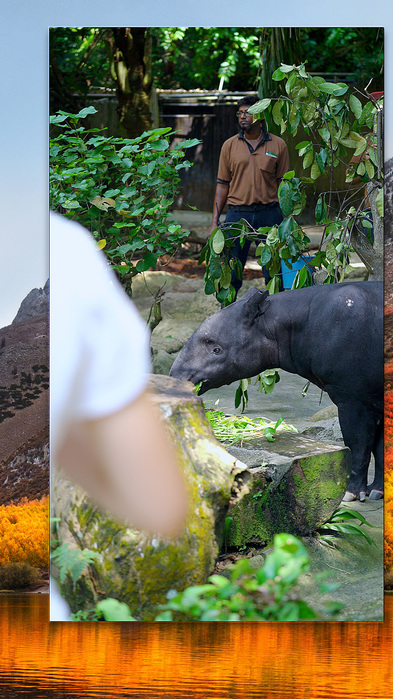-
From Current Issue
-
- Editor’s Letter Fire in the Heart
- Reviews I Gusti Ayu Kadek Murniasih
- Reviews 11th Seoul Mediacity Biennale: “One Escape at a Time”
- Dispatch Networked China
- One on One Monira Al Qadiri on Yukio Mishima
- Essays The rise of independent art spaces in pandemic-era Shanghai
- Features Tuan Andrew Nguyen
- Table of Contents
- Web Exclusives
- Archive
- Subscribe

R
E
V N
E
X
T
Installation view of HSU CHIA-WEI’s “Black and White – Malayan Tapir” at the International Studio & Curatorial Program, New York, 2018–19. Courtesy the International Studio & Curatorial Program.
Contrary to the binary clarity implied by its title, there was nothing straightforward about Hsu Chia-Wei’s video installation, Black and White – Malayan Tapir (2018), at the International Studio & Curatorial Program in New York, where Hsu was resident in 2010. Hsu is a storyteller of untold stories, weaving together multiple histories with myth and legend to queer the linear lens through which we are instructed to understand the past. As informative as Hsu’s stories are, which he mostly tells through film and video installation, they remain anti-didactic. Refusing to prioritize a single narrative over another, he lays out a constellation of intertwining perspectives, like an eye-opening tarot spread offering a multitude of readings.
Playing across four vertically adjoined screens is Hsu’s four-channel video, considered the second in a series representing the artist’s recent foray into recounting history through non-human perspectives after Black and White – Giant Panda (2018). In a similar vein, Malayan Tapir shrouds the titular, plump mammal in a mist of complicated subjects including British and Dutch colonization in Southeast Asia, the founding of modern Singapore, and a pissing contest between two British East India Company commanders and keen naturalists, William Farquhar and his supervisor Sir Stamford Raffles, over the region’s division and the animal’s discovery, all encapsulated in a tour delivered by an over-eager guide at the Singapore Zoo.
The video starts with a computer desktop background; then a mouse-click ushers in a window showing the zoo guide delivering a tour of the Malayan tapir enclosure to a crowd of onlookers busy capturing the moment on their phones. After about a minute of describing the animal’s main characteristics, the guide delves into a more expansive history of the Malayan tapir, tracing its contested discovery back to the early 19th century, when it was one of the animals Farquhar—who was the first British Resident and Commandant of Singapore—kept in his private zoo. All the while, windows containing images of natural history drawings, footage of taxidermied animals in glass display cases, and Google Image search results orchestrated by the artist’s audible mouse-clicks splice through and cascade over one another, illustrating this lineage until the guide’s image is no longer visible.
Although her image disappears for some time, the guide’s voice runs throughout the entire seven-minute video, narrating a mass of information that stretches so far as to list individual plants and animals that Farquhar commissioned drawings of. But just when the information starts to feel overwhelming, two identical statues of a man striking a commanding pose appear and morph into the black and white tapir, back in its enclosure and chewing a bunch of leaves, as if completely unbothered by the petty quarrels of the men claiming its discovery. Although unspecified in the video, the identical statues are of Raffles, the man credited with the founding of modern Singapore whose disputes with Farquhar led to the latter’s eventual removal from office.
Hsu’s video is a disorienting audiovisual overload that aptly illustrates the convoluted messiness of history. Although the work may seem to center around the Malayan tapir, the unassuming character emerges more as a supporting actor than a lead to shine a necessary light on what is arguably the real protagonist of the video: the futility of humanity’s destructive conquest of land and all that it contains. What the video does not mention is that, unsurprisingly, Malayan tapirs are at risk of extinction due to loss of habitat to palm oil plantations. It is hypothesized that one factor contributing to the Malayan tapir’s survival from the Eocene epoch to the present day is its solitary and timid nature. But in 1998, tragedy struck Oklahoma City Zoo when a female Malayan tapir mauled and bit off the arm of a zookeeper attempting to feed it and its baby. Although the attack was explained as a result of the mother’s protective instinct, perhaps it is also a hopeful reminder that what may seem docile and defenseless will one day fight back against those who pose a threat, however ignorantly.
Hsu Chia-Wei’s “Black and White – Malayan Tapir,” co-organized with the Taipei Cultural Center in New York, is on view at the International Studio & Curatorial Program, New York, until January 25, 2019.
To read more of ArtAsiaPacific’s articles, visit our Digital Library.
















